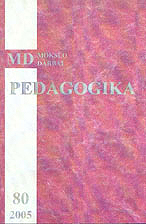Savireguliacijos modelis muzikos mokytojo atlikėjiškai veiklai tobulinti
The Self-Regulation Model to Activate the Music Teacher as a Performer
Author(s): Rasa KirliauskienėSubject(s): Education
Published by: Vytauto Didžiojo Universitetas
Keywords: self-regulation; music teacher; performer
Summary/Abstract: In the general curricula of Lithuanian secondary schools the necessity to encourage pupils to participate in performing activities (perfogming and listening in families, public performances, churches ets.) is mentioned. However a very clear and contradictory situation arises - on the one hand the music teacher has to arrange public performances of pupils on the other hand the teacher is not trained for this specific activity psychologically. This shows that selected topic of survey is very importunate. The aim of research was – theoretically and empirically to substantiate the self-regulation model enabling the future music teacher to optimaliose his/her emotional state. Conclusions. The development experiment performed applying the case method of anglysis not only confirms once again the clear university development optimization reserves of future music teachers. This important and relevant statement is substantiated and the necessary prerequisites of realization consists of the following: 1) the artistic psychic self model (the basius of which make up the personal meaning method PMM) theoretically proven and practically verified, for the optimization of scenic state helping the student: • to increase artistic interpretation suggestion for the listener because the object of performing activity becomes the emotional musical rudiment and each piece – an aesthetic conception, revealing the student‘s artistic individuality; • to cherish objective self-confidence and also to expand a self-development motivation system because during the development process the joy of success is felt more often and more clearly; • in the brain cortex of the head to weaken the dominant of excitement, because the modelling of the artistic image of the piece on the basis of emotiogenetic assocations (in natural way) creates its contrast – the desired artistic atidominant.
Journal: Pedagogika
- Issue Year: 2005
- Issue No: 80
- Page Range: 97-101
- Page Count: 5
- Language: Lithuanian

